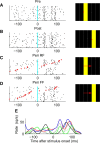Neural dynamics of saccadic suppression
- PMID: 19812313
- PMCID: PMC2787621
- DOI: 10.1523/JNEUROSCI.2908-09.2009
Neural dynamics of saccadic suppression
Abstract
We make fast, ballistic eye movements called saccades more often than our heart beats. Although every saccade causes a large movement of the image of the environment on our retina, we never perceive this motion. This aspect of perceptual stability is often referred to as saccadic suppression: a reduction of visual sensitivity around the time of saccades. Here, we investigated the neural basis of this perceptual phenomenon with extracellular recordings from awake, behaving monkeys in the middle temporal, medial superior temporal, ventral intraparietal, and lateral intraparietal areas. We found that, in each of these areas, the neural response to a visual stimulus changes around an eye movement. The perisaccadic response changes are qualitatively different in each of these areas, suggesting that they do not arise from a change in a common input area. Importantly, our data show that the suppression in the dorsal stream starts well before the eye movement. This clearly shows that the suppression is not just a consequence of the changes in visual input during the eye movement but rather must involve a process that actively modulates neural activity just before a saccade.
Figures








References
-
- Bisley JW, Goldberg ME. Neuronal activity in the lateral intraparietal area and spatial attention. Science. 2003;299:81–86. - PubMed
-
- Born RT, Bradley DC. Structure and function of visual area MT. Annu Rev Neurosci. 2005;28:157–189. - PubMed
-
- Bremmer F, Ilg UJ, Thiele A, Distler C, Hoffmann KP. Eye position effects in monkey cortex. I. Visual and pursuit-related activity in extrastriate areas MT and MST. J Neurophysiol. 1997a;77:944–961. - PubMed
-
- Bremmer F, Distler C, Hoffmann KP. Eye position effects in monkey cortex. II. Pursuit- and fixation-related activity in posterior parietal areas LIP and 7A. J Neurophysiol. 1997b;77:962–977. - PubMed
Publication types
MeSH terms
Grants and funding
LinkOut - more resources
Full Text Sources
